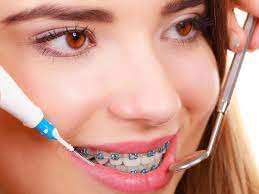 Having dental braces is an effective way to improve the health and appearance of your teeth. This type of treatment can also improve your facial appearance and give you a more aesthetically pleasing smile. Aside from improving your appearance, dental braces can also make eating more comfortable.
Having dental braces is an effective way to improve the health and appearance of your teeth. This type of treatment can also improve your facial appearance and give you a more aesthetically pleasing smile. Aside from improving your appearance, dental braces can also make eating more comfortable.
A dental brace is a set of wires and brackets that are bonded together. They are usually stainless steel or ceramic. These wires are attached to the teeth with archwires. The archwires are usually nickel titanium or copper. These wires connect the brackets on the teeth and apply pressure to the teeth to move them. These wires can also be used instead of elastic ligatures. You may find more information at braces near me
A dental brace is often used to correct crowded teeth. Overcrowded teeth can make cleaning your teeth difficult. Crooked teeth are also bad for your oral health. They can also make you more susceptible to cavities. If left untreated, crooked teeth can also affect your speech. Untreated crooked teeth may also lead to gum disease.
Braces can also be used to correct extreme overbite. This type of treatment is often performed with removable retainers. In addition, fixed orthodontics can be performed for people of all ages.
An orthodontist is a dentist who specializes in a specific area of dentistry, like identifying and correcting malocclusions. He or she will examine your teeth and take pictures and impressions of them. They will then create a treatment plan. An orthodontist will evaluate your teeth for any problems and make a recommendation for the best treatment for you.
Most people get braces during their adolescence. However, some adults need braces as well. This is because their jaws change as they grow. The teeth in adolescence are more flexible and may respond to treatment more quickly than teeth in adulthood.
Braces can also be used to help impacted teeth erupt. These teeth may not erupt at the right age or may stay buried in the jaw bone. This can lead to severe infections. The dentist may also decide to extract some teeth.
Some people want to wear invisible braces. Although this option can help them correct minor gaps, it can’t treat more severe misalignment. It’s also very expensive. If you are considering wearing invisible braces, you should talk to your dentist before deciding. This may mean you need to have conventional metal braces instead.
During your first few weeks of wearing braces, you may experience aching or soreness. You may also experience mouth sores inside your lips. The soreness usually subsides after a couple of weeks. If you do have mouth sores, you may be prescribed over-the-counter pain killers. The braces can also cause canker sores.
After your first few weeks, you may begin to feel more comfortable. You may also start to have problems eating. You may need to use a saltwater solution to help relieve pressure. After the first few weeks, your braces will be almost invisible. You will continue to have appointments with your orthodontist.